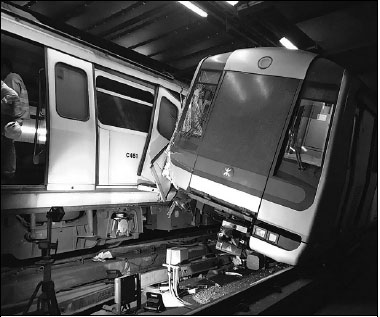Subway trains collide in HK during trial
2019-03-19 08:59:53Two train captains were sent to the hospital in Hong Kong, one with a leg injury, after two subway trains collided on Monday morning after a signal failure. No passengers were on board.
The incident occurred during ongoing trial runs for a new signal system. It was said to be the first collision since the operator started providing services in the city in 1979.
Train service between Central and Admiralty stations on the Tsuen Wan Line, both among the city's busiest transfer stations on Hong Kong Island, was suspended on Monday and unlikely to resume on Tuesday morning, according to the rail operator.
The collision took place near Central Station at around 3 am when a Tsuen Wan-bound train collided with a Central-bound train at the crossover section. The Tsuen Wan subway line links Tsuen Wan station in the New Territories and Central station on Hong Kong Island.
The collision damaged both trains, and one derailed. The other's carriages were bent, with doors unhinged and windows shattered.
Trains running between Admiralty and Tsuen Wan stations departed every 3.5 minutes on Monday. Commuters were advised to use the Hong Kong Island Line to travel between Central and Admiralty.
In a media briefing on Monday afternoon, Jacob Kam Chak-pui, managing director of MTR, the rail operator, cited flawed software provided by the supplier as a possible reason for the collision.
A special task force, including experts from MTR, the supplier of the new system and third parties, will look into the incident.
MTR will submit an initial investigation report in two to three months.
Earlier on Monday, Adi Lau Tinshing, operations director for MTR, told reporters that the company would suspend all testing of the new signal system until the cause of the collision was determined.
A similar signal failure caused an unprecedented service delay of four MTR lines - lasting about six hours - in October. The company was fined about HK$8 million ($1.04 million), which is expected to be used as monetary compensation to Hong Kong people in the form of a fare deduction in 2019.
In 2015, MTR invested HK$3.3 billion to upgrade the signaling system of all the trains along seven railways covering most train stations, to increase service efficiency, reliability and passenger capacity. On the Tsuen Wan Line, sectional testing started in 2016 and full-line testing began in 2018.
Before Monday's incident, the new signaling system had been expected to be gradually adopted to work with the existing one in the second half of this year.
The Hong Kong Special Administrative Region's government expressed great concern over the accident. In a statement issued on Monday morning, Secretary for Transport and Housing Frank Chan Fan requested that MTR conduct a thorough investigation into the cause of the accident.
Calling the accident the most severe in MTR's history, Hong Kong lawmaker and chairman of the Legislative Council's panel on transport Ben Chan Han-pan said a comprehensive investigation is needed.
Chan asked why the two trains' collision avoidance system had failed and demanded that the company ascertain whether it was caused by human error or a design flaw.
|
The crash site on Hong Kong subway's Tsuen Wan Line. Two trains collided during a trial run. |

